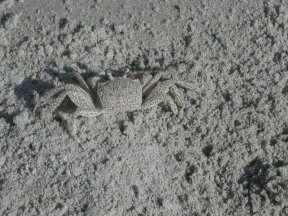
NPS Photo Ghost crabs, also called Sand crabs, are so named because of their ability to blend into the sandy beaches and dunes in which they live. Six strong legs are capable of carrying Ghost crabs along at speeds up to 10 mph, allowing them to disappear quickly from sight (yet another reason for the name). During the day, they spend most of their time housekeeping and digging their burrows. Extending from the carapace, or top section of exoskeleton, are two black eyes that are able to see 360 degrees simultaneously; however, they are unable to see directly overhead. You can often spot ghost crabs at night, which is when they feed on other crabs, clams, lizards, insects and detritus. Ghost crabs make golf ball-sized entrance holes in the dry sand. These tunnels can go deeper than three to four feet, extending to the water table below. Their sandy homes open into a chamber which ghost crabs design for a space in which to turn-around. Ghost crabs will hibernate in their burrows during the winter, “holding their breath” for up to six weeks by storing oxygen in special sacs near their gills. When not hibernating, they will periodically wet their gills in order to filter oxygen from the sea or the water at the bottom of their burrows. Although they cannot swim, they sometimes enter the shallows, not only to replenish water and oxygen, but to escape predators, such as birds and raccoons. Keep your eyes open, and you just might catch a glimpse of Padre Island’s “ghosts.” |
Last updated: September 21, 2016
